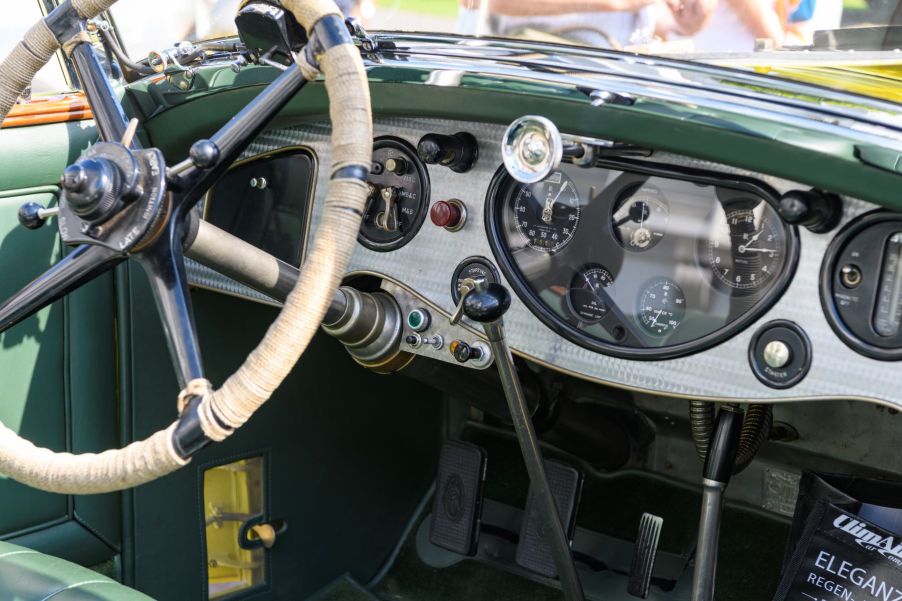
A History of the Manual Transmission
The manual transmission is a bit of a dying breed. With fewer and fewer manufacturers making them, they’re slowly becoming a thing of the past. However, some are still around, primarily associated with sports cars. However, even in that vehicle class, they’re slowly being phased out as more and more people don’t know how to drive one. Let’s look at the manual transmission’s history.
A brief history of the manual transmission

A transmission is one of the essential parts of a car. It allows the driver to control the speed and power of the vehicle. According to Carbuzz, the first manual transmissions were created in 1894 by French inventors Louis-Rene Panhard and Emile Levassor. These early manual transmissions were single-speed and used a belt to transmit power to the drive axle.
Manual transmissions became more popular in the early 20th century as cars began mass production. The clutch, which allows drivers to disengage the drive from the engine to the wheels, was invented in 1905 by English engineer Professor Henry Selby Hele-Shaw. However, these early manual models were challenging to use and often resulted in grinding and crunching noises.
To improve manual transmission, manufacturers began to add more gears. This made it easier for drivers to control the speed and power of their cars. Today, manual transmissions are an essential part of many cars and are enjoyed by drivers worldwide.
The evolution of manual transmissions
Manual transmission drivers had to match the speed of the engine’s input shaft to the gear selected. This is a process known as “rev-matching.” Synchromesh, invented in 1919 by Earl Avery Thompson, automatically matches these speeds. When using synchronizer rings to connect two moving parts rotating at different rates, grid gears can only be adequately engaged by depressing the clutch pedal. Synchromesh can be considered a small clutch that speeds up or slows the relative speed of the required gear for engagement.
The first cars to use synchromesh were Cadillac and LaSalle in America in 1928. However, the first car to use synchromesh in all forward gears was the 1952 Porsche 356. This luxurious car came with a four-speed manual, which was one speed more than most.
Manual transmissions were the norm for many years until automatic transmissions became more popular in the late 1970s. During this time, gated shifters were also standard on higher-end cars. This type of shifter ensured that drivers kept the throws of the stick uniform. However, modern car connections are accurate enough to make gated shifters unnecessary. Therefore, many gated shifters on today’s cars are for aesthetics.
Manual transmission downshifting can be tricky and may take some getting used to. It is, however, an essential skill to learn for performance driving. Downshifting can affect stability under braking and cause issues if not done correctly. The key to successful downshifting is timing a blip of the throttle before lifting the clutch to match the speed of the lower gear. This will help to smooth out the change and avoid any potential problems. With some practice, manual downshifting can be easy and second nature.
Nissan’s SynchroRev Match system was introduced on the 370Z in 2009 as part of the Sport package. The system blips the throttle on the downshift and upshift, providing a smoother stick shift experience. This technology has since appeared on other cars, such as the BMW M2 CS, Honda Civic Type R, Chevrolet Camaro SS, and the Ford Mustang Mach 1 manual models.
Manuals are fading away
Historically, manual transmissions offered a much broader range of gear choices than automatic ones, which gave drivers more control over their vehicle’s performance. Stick shifts also used to be more reliable than automatic transmissions due to their more straightforward design.
Additionally, manual transmissions typically offered better fuel economy than automatics due to their lack of energy-wasting torque converters, but this advantage has waned over time with new technology and designs. Still, stick shifts are often more fun to drive than automatics, as they require more driver involvement. Lastly, they still have a loyal following among car enthusiasts and continue to be popular in specific market segments.
Although manual transmissions offer many advantages over automatics, they have largely fallen out of favor in recent years. This is partly due to the increased popularity of automatic transmissions, which are seen as more convenient and easier to use. Additionally, manual transmissions are less common in newer vehicles, as many manufacturers have stopped offering them.


